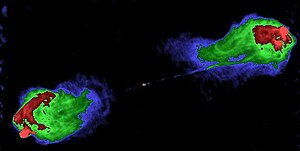Cygnus A
| Cygnus A | |
|---|---|
 |
|
| Observation data (J2000 epoch) | |
| Constellation | Cygnus |
| Right ascension | 19h 59m 28.3566s |
| Declination | +40° 44′ 02.096″ |
| Redshift | 0.056075 ± 0.000067 |
| Distance | 263 MPC |
| Apparent magnitude (V) | 16.22 |
| Characteristics | |
| Type | E |
| Apparent size (V) | 0.549' × 0.457' |
| Other designations | |
| 4C 40.40, 2E 4309, CYG A, W 57, BWE 1957+4035, NRAO 620, 1C 19.01, QSO B1957+405, 3C 405, 1RXS J195928.7+404405, 3C 405.0, 2U 1957+40, 3CR 405, LEDA 63932, 4U 1957+40, VV2000c J195928.3+404402, DA 500, MCG+07-41-003, DB 117, Mills 19+4, VV 72, PGC 63932. | |
Cygnus A (3C 405) is a radio galaxy, and one of the strongest radio sources in the sky. It was discovered by Grote Reber in 1939. In 1951, Cygnus A, along with Cassiopeia A, and Puppis A were the first "radio stars" identified with an optical source. Of these, Cygnus A became the first radio galaxy; the other two being nebulae inside the Milky Way. In 1953 Roger Jennison and M K Das Gupta showed it to be a double source. Like all radio galaxies, it contains an active galactic nucleus.
Images of the galaxy in the radio portion of the electromagnetic spectrum show two jets protruding in opposite directions from the galaxy's center. These jets extend many times the width of the portion of the host galaxy which emits radiation at visible wavelengths. At the ends of the jets are two lobes with "hot spots" of more intense radiation at their edges. These hot spots are formed when material from the jets collides with the surrounding intergalactic medium.
In fiction, Cygnus A appears in Carl Sagan's Contact as the result of beings actively creating a galaxy.
...
Wikipedia
